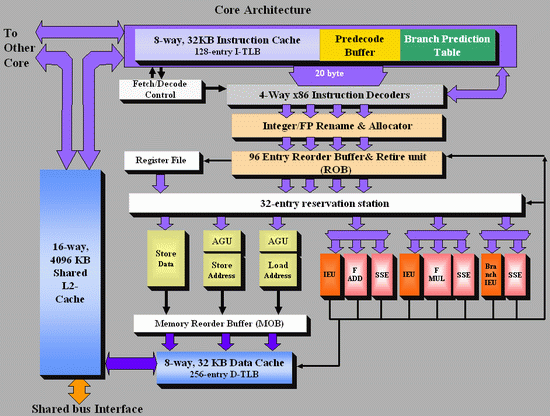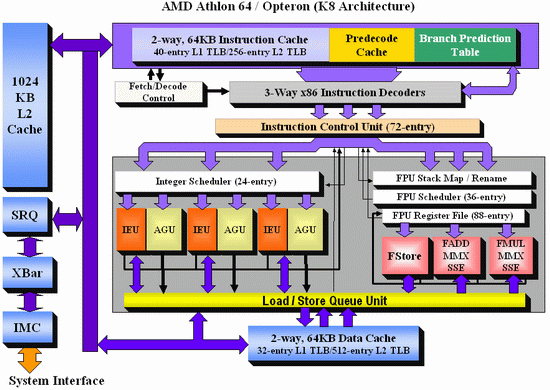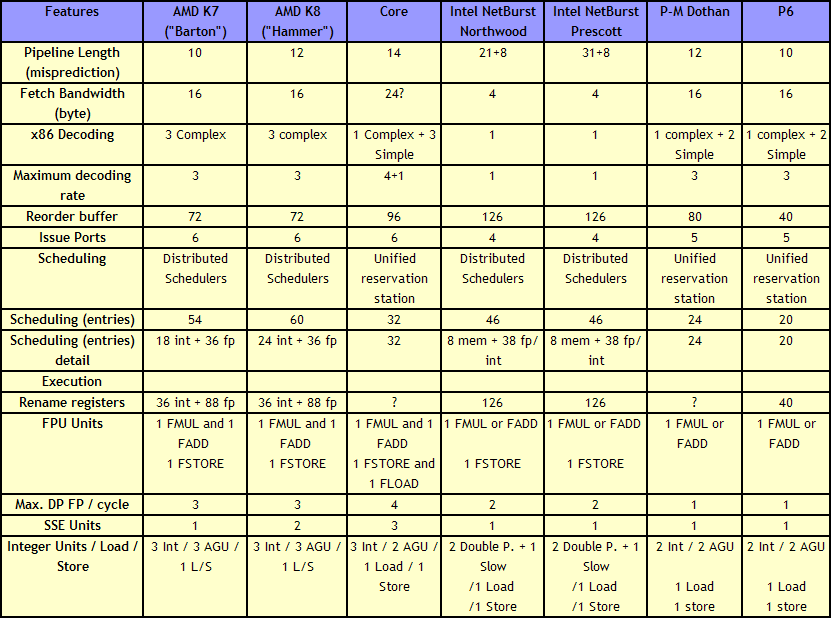Ten Year Anniversary of Core 2 Duo and Conroe: Moore’s Law is Dead, Long Live Moore’s Law
by Ian Cutress on July 27, 2016 10:30 AM EST- Posted in
- CPUs
- Intel
- Core 2 Duo
- Conroe
- ITRS
- Nostalgia
- Time To Upgrade
Core: Out of Order and Execution
After Prefetch, Cache and Decode comes Order and Execution. Without rehashing discussions of in-order vs. out-of-order architectures, typically a design with more execution ports and a larger out-of-order reorder buffer/cache can sustain a higher level of instructions per clock as long as the out-of-order buffer is smart, data can continuously be fed, and all the execution ports can be used each cycle. Whether having a super-sized core is actually beneficial to day-to-day operations in 2016 is an interesting point to discuss, during 2006 and the Core era it certainly provided significant benefits.
As Johan did back in the original piece, let’s start with semi-equivalent microarchitecture diagrams for Core vs. K8:
For anyone versed in x86 design, three differences immediately stand out when comparing the two. First is the reorder buffer, which for Intel ranks at 96 entries, compared to 72 for AMD. Second is the scheduler arrangement, where AMD uses split 24-entry INT and 36-entry FP schedulers from the ‘Instruction Control Unit’ whereas Intel has a 32-entry combined ‘reservation station’. Third is the number of SSE ports: Intel has three compared to two from AMD. Let’s go through these in order.
For the reorder buffers, with the right arrangement, bigger is usually better. Make it too big and it uses too much silicon and power however, so there is a fine line to balance between them. Also, the bigger the buffer it is, the less of an impact it has. The goal of the buffer is to push decoded instructions that are ready to work to the front of the queue, and make sure other instructions which are order dependent stay in their required order. By executing independent operations when they are ready, and allowing prefetch to gather data for instructions still waiting in the buffer, this allows latency and bandwidth issues to be hidden. (Large buffers are also key to simultaneous multithreading, which we’ll discuss in a bit as it is not here in Core 2 Duo.) However, when the buffer has the peak number of instructions being sent to the ports every cycle already, having a larger buffer has diminishing returns (the design has to keep adding ports instead, depending on power/silicon budget).
For the scheduler arrangements, using split or unified schedulers for FP and INT has both upsides and downsides. For split schedulers, the main benefit is entry count - in this case AMD can total 60 (24-INT + 36-FP) compared to Intel’s 32. However, a combined scheduler allows for better utilization, as ports are not shared between the split schedulers.
The SSE difference between the two architectures is exacerbated by what we’ve already discussed – macro-op fusion. The Intel Core microarchitecture has 3 SSE units compared to two, but also it allows certain SSE packed instructions to execute within one instruction, due to fusion, rather than two. Two of the Intel’s units are symmetric, with all three sporting 128-bit execution rather than 64-bit on K8. This means that K8 requires two 64-bit instructions whereas Intel can absorb a 128-bit instruction in one go. This means Core can outperform K8 on 128-bit SSE on many different levels, and for 64-bit FP SSE, Core can do 4 DP per cycle, whereas Athlon 64 can do 3.
One other metric not on the diagram comes from branch prediction. Core can sustain one branch prediction per cycle, compared to one per two cycles on previous Intel microarchitectures. This was Intel matching AMD in this case, who already supported one per cycle.













158 Comments
View All Comments
bcronce - Wednesday, July 27, 2016 - link
My AMD 2500+XP lasted me until a Nahalem i7 2.66ghz. It was a slight.... upgradeartk2219 - Friday, July 29, 2016 - link
Very minor, im sure you barely noticed :).jjpcat@hotmail.com - Wednesday, July 27, 2016 - link
I have a Q6600 in my household and it's still running well.In term on performance, E6400 is about the same as the CPUs (e.g. z3735f/z3745f) used in nearly all cloudbook these days.
Michael Bay - Thursday, July 28, 2016 - link
Yep, I was surprised at that when looking through the benchmarks. Turns out Atom is not so slow after all.stardude82 - Wednesday, July 27, 2016 - link
I've just finished decommissioning all my Core 2 Duo parts, several of which have been upgraded with 2nd hand Sandy Bridge components.Yeah, CPU performance has been relatively stagnant. CPUs have come to where commercial jets are now in their technological development. Jets now fly slower than they did the 1960s, but have much better fuel economy per seat.
Not noted in the E6400 v. i5-6600 comparison is that they both have the same TDP which is pretty impressive. Also, you've got to take inflation into account which would bring the CPU price up to $256 or there about, enough for a i5-6600K.
ScottAD - Wednesday, July 27, 2016 - link
One could argue that while Core put Intel on top of the heap again, Sandy Bridge was a more important shift in design and as a result, many users went from Conroe to Sandy Bridge and have stayed there.That pretty much defines my PC currently. Haven't needed to upgrade. Crazy a decade like nothing.
ianmills - Wednesday, July 27, 2016 - link
When a website has trouble keeping up with current content and instead recycles decades old content.... things that make you go hmm...Ian Cutress - Wednesday, July 27, 2016 - link
I'm the CPU editor, we've been up to date for every major CPU launch for the last couple of years, sourcing units that Intel haven't sourced other websites and have done comprehensive and extensive reviews of every leading x86 development. We have had every Haswell-K (2), Haswell-E(3) Broadwell (2), Broadwell E3 Xeon (3), Broadwell-E (4) and Skylake-K (2) CPU tested and reviewed on each official day of launch. We have covered Kaveri and Carrizo in deep repeated detail over the last few years as well.This is an important chip and today marks in an important milestone.
Hmm...?
smilingcrow - Wednesday, July 27, 2016 - link
Ananand do CPUs very well, can't think of anyone better. Kudos and thanks to you 'guys'."This primarily leaves ARM (who was recently acquired by Softbank)"
They are under offer so not guaranteed to go through and ARM isn't a person. :)
ianmills - Wednesday, July 27, 2016 - link
I agree you do a good job with CPU's. Its some of the other topics that this site has been slowed down in when compared to previous years